In recent years, the integration of AI in drone swarming technology has sparked significant interest across various industries. From military applications to commercial use, the ability of drones to operate as a cohesive unit opens up a world of possibilities. This article delves into how artificial intelligence is transforming drone swarming technology and what it means for the future of aerospace.

What is Drone Swarming?
Drone swarming refers to the concept of multiple drones working together in a synchronized manner, much like a flock of birds. The idea is to perform tasks more efficiently than a single drone could accomplish alone. The incorporation of AI allows these swarms to operate autonomously, making real-time decisions without human intervention.
The Role of AI in Drone Swarms
AI plays a pivotal role in enabling drones to communicate, collaborate, and make decisions. This involves complex algorithms that process data from various sensors to determine the best course of action. By leveraging machine learning, drones can adapt to changing environments and complete missions with precision.
Applications of AI-Driven Drone Swarming
The applications of AI in drone swarming technology are broad and varied. In the military sector, swarms can be used for surveillance, reconnaissance, and even offensive operations. On the commercial side, they can assist in agriculture by monitoring crops, spraying pesticides, and gathering data. Additionally, swarms are utilized in disaster response, providing critical information and delivering supplies to hard-to-reach areas.
AI and Military Advancements
The military is one of the biggest beneficiaries of AI-driven drone swarming. Swarms can carry out complex missions with high efficiency, reducing the need for human soldiers in dangerous situations. According to an article on AI in aerospace, these advancements enhance national security and provide a strategic advantage.
Challenges in Implementing AI in Drone Swarms
Despite the potential, there are several challenges to implementing AI in drone swarming technology. One major issue is ensuring reliable communication between drones, especially in environments with poor signal quality. Additionally, the ethical implications of autonomous drones in warfare and privacy concerns in civilian applications are hotly debated topics.
Communication and Coordination
Effective communication is crucial for the success of drone swarms. AI must process data rapidly to maintain coordination and avoid collisions. This requires robust algorithms capable of handling high volumes of information in real time.
Ethical and Privacy Concerns
The use of autonomous drones raises ethical questions, particularly in military settings. The potential for unintended harm and accountability in decision-making processes is a concern. Similarly, in civilian applications, privacy issues arise as drones collect vast amounts of data from the environment.
The Future of AI in Drone Swarming
As AI technology continues to evolve, the capabilities of drone swarms will expand. Future advancements may lead to more efficient algorithms, improved communication systems, and enhanced adaptability. The potential for innovation in this field is immense, promising to revolutionize how we approach aerial tasks.
Advancements in Machine Learning
Machine learning is at the heart of future developments in AI-driven drone swarming. By continuously learning from data, drones can improve their performance, making them more reliable and effective. Innovations in this area will drive the next generation of drone technology.
Integration with Other Technologies
The integration of AI with other emerging technologies, such as 5G and edge computing, will further enhance the capabilities of drone swarms. These technologies will provide faster data processing and real-time analytics, essential for mission-critical operations.
Conclusion
The integration of AI in drone swarming technology is shaping the future of aerospace innovation. While challenges remain, the potential benefits are too significant to ignore. As we continue to develop and refine these technologies, drone swarms will become an integral part of our daily lives, transforming industries and enhancing our capabilities.

FAQ
What is the main purpose of drone swarming technology?
The main purpose of drone swarming technology is to perform complex tasks more efficiently by utilizing multiple drones that work together autonomously. This technology is used in various fields, including military, agriculture, and disaster response.
How does AI improve the functionality of drone swarms?
AI improves the functionality of drone swarms by enabling real-time decision-making, communication, and coordination. It allows drones to adapt to changing environments and complete missions with greater precision.
What are the challenges associated with AI in drone swarming?
The challenges associated with AI in drone swarming technology include reliable communication between drones, ethical concerns in military applications, and privacy issues in civilian use.
For more insights into AI applications in aerospace, visit trajectory prediction and structural fatigue.

